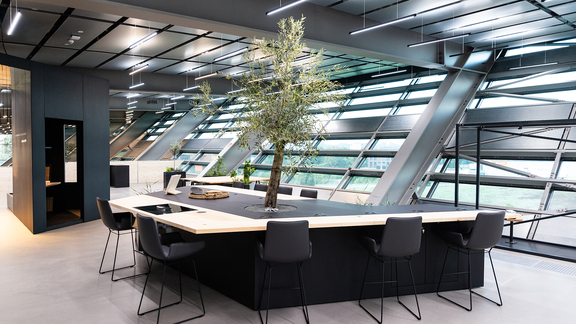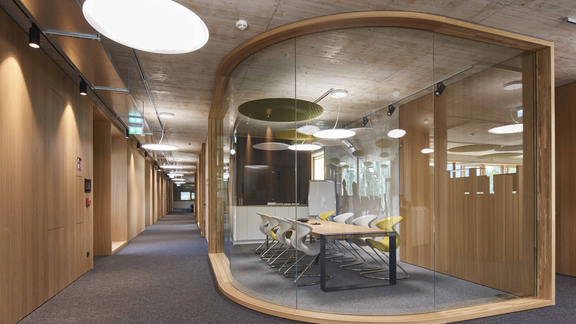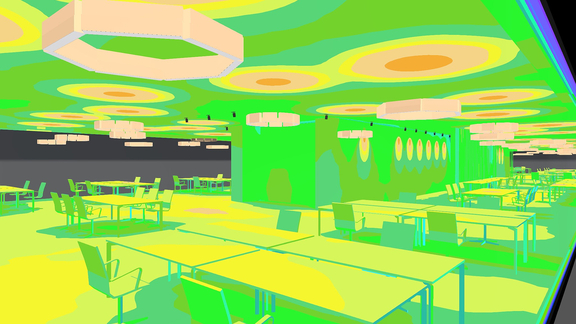

The right lighting is an important aspect when planning any room – whether a home kitchen or a commercial office.
Light can affect people’s mood and concentration in various ways. We explain the BORA lighting concept, which we have developed in cooperation with the lighting designers at Licht im werkhaus, and offer you expert knowledge on how to properly plan lighting.
BORA is growing. A new building is currently being constructed at our company site in Niederndorf, Austria, which should act as a workplace for additional employees from the end of 2023. In general, people spend a third of their life in the workplace. As such, the right lighting isn’t just an important part of creating a striking architectural design, but also imperative for our health. Find out more in the interview below.
The right lighting not only influences the appearance of a room, but also the mood of the people within it. If we want to prepare food, the illumination of the worktop area is important. If we want to eat the meal we have cooked in an enjoyable atmosphere, warm, perhaps even slightly dimmed lighting is more emotional. If we are sitting at a desk and need to concentrate, optimum lighting conditions are particularly important. Here at BORA, we have therefore always focused on creating the right lighting concept.

We interviewed the experts from Licht im werkhaus and asked them why a coherent lighting concept in the workplace is so important, how light actually works and what the primary considerations were when designing the lighting for the BORA company sites.
Why is a coherent lighting concept in the workplace important?
Whatever the time of day, the right lighting in our homes and the workplace plays a key role in determining whether we feel comfortable, awake, motivated and productive. The brightness also affects how quickly we are able to relax. Having enough light helps us concentrate better and increases our sense of satisfaction. It also affects our health.
What different types of light (sources) are there?
We differentiate between daylight and artificial light. Daylight or sunlight contains important vitamin D, which helps the body absorb and process calcium. This is essential for bone formation and stability. The BORA company buildings were designed with as much glazing as possible to allow plenty of daylight to reach right to the backs of the rooms.
Artificial light is produced by light fixtures that ‘imitate’ daylight. The light colour and brightness are important in this regard. In the case of dimmable bulbs, the intensity of the light can be adjusted in line with the time of day.

What are the differences between direct and indirect lighting?
When it comes to working environments in particular, direct and indirect lighting play an important role. Direct lighting falls directly on a specific object or area without interruption in order to make it a focal point. It is characterised by a higher light density and more brilliant colours. Direct lighting is used in situations where greater brightness is required – and that includes workplaces.
Indirect lighting, on the other hand, is reflected off a wall or room feature before spreading out into the room in a diffused manner. This glare-free lighting is very soft on the eye and does not form sharp contrasts between light and shadow. Indirect lighting can be used to provide the basic lighting within a room.
What is the relationship between brightness and light colour?
The planned brightness helps us perform visual tasks. Light colours affect people’s sleep-wake cycle. This circadian rhythm is omnipresent in nature, for example flowers open and close depending on the brightness. In principle, the higher the light density, i.e. the greater the brightness, the whiter the light colour can be.

How was the lighting for the BORA company buildings designed?
We placed great emphasis on the use of human centric lighting (HCL) technology. HCL is a concept where the right light for the prevailing life or working situation is provided at all times. At BORA, the colour temperature and brightness of the intelligent, HCL-controlled bulbs in the workspaces automatically adapt to the natural lighting conditions over the course of the day.
What is special about the lighting in the BORA company buildings?
The lighting concept at BORA not only promotes employee health, wellbeing and performance but also externally emphasises the buildings’ striking appearances, which supports their architectural designs – highlighting impressive architecture through optimum lighting design.

A further building is currently being constructed at our Niederndorf site in Austria. Is there anything special about the lighting concept being used compared to that in the existing building?
The existing building, which employees simply know as ‘AT I’, was a pilot project for the aforementioned HCL technology. When designing the lighting, we primarily focused on targeted, predefined workstation lighting through the use of individual pendant luminaires.
In the new building currently under construction, ‘AT III’, the architectural lighting is more reserved than in ‘AT I’. This means that there will be more ambient lighting in order to provide maximum flexibility for the ever-changing workstation layouts.
